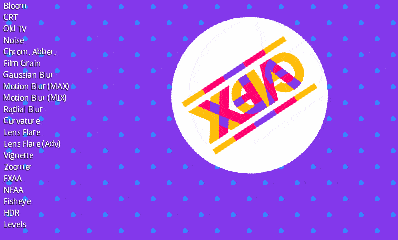This is a fork of gdx-vfx, a flexible post-processing library for libGDX. The main changes in this fork are:
- An update to libGDX 1.10.0
- Support for OpenGL 3 on macOS (shaders are automatically ported to GLSL 1.50)
- Support for depth
- Uses
NestableFrameBuffers from guacamole instead ofVfxFrameBuffers; removes the coupledRenderers - Improves alpha blending for the following effects: lens flare, old tv, radial distortion and vignetting
- Renames some methods:
beginInputCapture()->beginCapture(),endInputCapture()->endCapture(),cleanUpBuffers()->clear(),anyEnabledEffects()->hasEffects() - Heavily refactors a lot of the internal classes in the library
Gdx-vfx itself is based on libgdx-contribs-postprocessing, with lots of improvements and heavy refactoring. The goal is to focus on stability, offer lightweight integration and provide a simple mechanism to implement effects.
Read more about the library at the wiki introduction page.
Visit https://crashinvaders.github.io/gdx-vfx
Or clone and play with the demo locally:
git clone https://github.com/crashinvaders/gdx-vfx.git
cd gdx-vfx
./gradlew demo:desktop:run
The library's releases are available through Jitpack.
Add it in your root build.gradle at the end of repositories:
allprojects {
repositories {
maven { url "https://jitpack.io" }
}
}Add the dependency:
dependencies {
implementation "com.github.crykn.gdx-vfx:gdx-vfx-core:$vfxVersion"
implementation "com.github.crykn.gdx-vfx:gdx-vfx-effects:$vfxVersion" // Optional, if you need standard filter/effects.
}The library is fully HTML/GWT compatible, but requires an extra dependency to be included in the GWT module in order to work properly.
Please take a look at the GWT integration guide.
dependencies {
implementation "com.github.crykn.gdx-vfx:gdx-vfx-gwt:$vfxVersion"
}A simple example of a LibGDX application that applies gaussian blur effect to a geometry drawn with ShapeRenderer.
import com.badlogic.gdx.ApplicationAdapter;
import com.badlogic.gdx.Gdx;
import com.badlogic.gdx.graphics.Color;
import com.badlogic.gdx.graphics.GL20;
import com.badlogic.gdx.graphics.Pixmap;
import com.badlogic.gdx.graphics.glutils.ShapeRenderer;
import com.crashinvaders.vfx.VfxManager;
import com.crashinvaders.vfx.effects.GaussianBlurEffect;
public class VfxExample extends ApplicationAdapter {
private ShapeRenderer shapeRenderer;
private VfxManager vfxManager;
private GaussianBlurEffect vfxEffect;
@Override
public void create() {
shapeRenderer = new ShapeRenderer();
// VfxManager is a host for the effects.
// It captures rendering into internal off-screen buffer and applies a chain of defined effects.
vfxManager = new VfxManager();
// Create and add an effect.
// VfxEffect derivative classes serve as controllers for the effects.
// They provide public properties to configure and control them.
vfxEffect = new GaussianBlurEffect();
vfxManager.addEffect(vfxEffect);
}
@Override
public void resize(int width, int height) {
// VfxManager manages internal off-screen buffers,
// which should always match the required viewport (whole screen in our case).
vfxManager.resize(width, height);
shapeRenderer.getProjectionMatrix().setToOrtho2D(0f, 0f, width, height);
shapeRenderer.updateMatrices();
}
@Override
public void render() {
// Clean up the screen.
Gdx.gl.glClearColor(0f, 0f, 0f, 1f);
Gdx.gl.glClear(GL20.GL_COLOR_BUFFER_BIT);
// Clean up internal buffers, as we don't need any information from the last render.
vfxManager.clear();
// Begin render to an off-screen buffer.
vfxManager.beginCapture();
// Here's where game render should happen.
// For demonstration purposes we just render some simple geometry.
shapeRenderer.begin(ShapeRenderer.ShapeType.Filled);
shapeRenderer.setColor(Color.PINK);
shapeRenderer.rect(250f, 100f, 250f, 175f);
shapeRenderer.setColor(Color.ORANGE);
shapeRenderer.circle(200f, 250f, 100f);
shapeRenderer.end();
// End render to an off-screen buffer.
vfxManager.endCapture();
vfxManager.update(Gdx.graphics.getDeltaTime());
// Apply the effects chain to the captured frame.
// In our case, only one effect (gaussian blur) will be applied.
vfxManager.applyEffects();
// Render result to the screen.
vfxManager.renderToScreen();
}
@Override
public void dispose() {
// Since VfxManager has internal frame buffers,
// it implements Disposable interface and thus should be utilized properly.
vfxManager.dispose();
// *** PLEASE NOTE ***
// VfxManager doesn't dispose attached VfxEffects.
// This is your responsibility to manage their lifecycle.
vfxEffect.dispose();
shapeRenderer.dispose();
}
}The actual example code can be found here.


